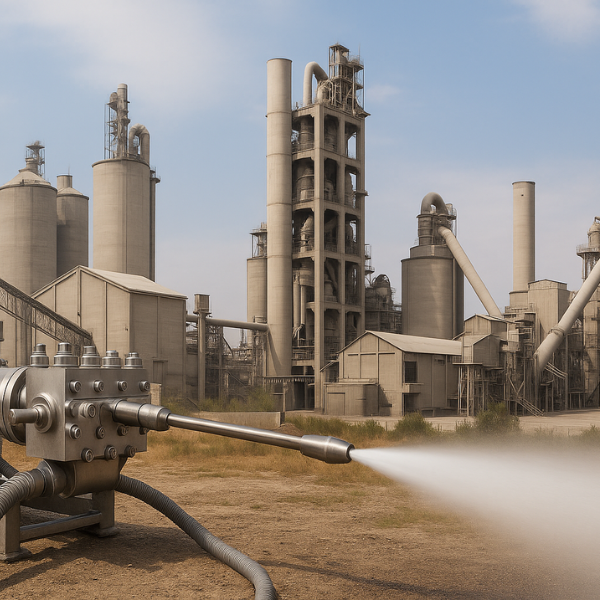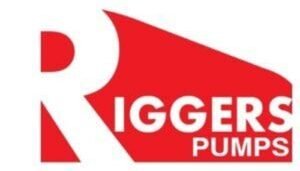Water Jetting System for Cement Plants | Efficient Dust Suppression & Surface Cleaning
Water jetting systems for cement plants are essential for maintaining the cleanliness, efficiency, and safety of plant operations. These systems use high-pressure water jets to clean and maintain equipment, remove debris, suppress dust, and ensure the smooth operation of critical machinery like kilns, conveyors, mixers, and cement mills.
Our water jetting systems for cement plants provide eco-friendly, non-abrasive cleaning, offering a cost-effective, safe, and efficient solution for tackling the demanding environments of cement production.
How Water Jetting Systems Work in Cement Plants
Water jetting systems use high-pressure water to remove debris, scale, and dust from plant equipment. Key components of these systems include:
How It Works
High-Pressure Pump: Delivers the required pressure (typically 500 bar to 2800 bar) to clean surfaces effectively
Rotary Nozzles: Spin to distribute water evenly across large surfaces, removing contaminants
Flexible Hoses & Lances: Reach deep into difficult-to-access areas, such as inside pipes, kiln tubes, and ducts
Control System: Provides precise control over water flow and pressure, ensuring optimal cleaning results
Water Recovery Systems (Optional): Collect and filter used water for reuse, promoting sustainability and minimizing water waste
Technical Specifications
- Pressure Range: 500 – 2800 bar (customized for various plant equipment)
- Flow Rate: 15 – 200 LPM
- Power Sources: Electric, Diesel, or Hydraulic-powered
- Nozzle Types: Rotary nozzles, fixed nozzles, and specialty nozzles for different applications
- Pump Type: Triplex Plunger Pumps, Axial Piston Pumps, or Gear Pumps for durability
- Mounting Options: Skid, Trailer, or Vehicle-mounted for portability
- Water Recovery: Optional systems to collect and filter used water for reuse
- Control Systems: Manual or fully automated systems for easy operation

Applications of Water Jetting Systems in Cement Plants
Water jetting systems in cement plants are used for a variety of applications, including:
Dust Suppression: Reduces airborne dust created during material handling and processing, ensuring a cleaner and safer environment
Cement Kiln Cleaning: Removes scale and buildup from cement kilns to improve heat efficiency and prevent obstructions
Cement Mill and Conveyor Cleaning: Cleans conveyors and cement mills from debris, preventing blockages and improving material flow
Surface Preparation: Prepares surfaces of equipment for maintenance, inspections, or repairs
Boiler and Heat Exchanger Cleaning: Removes soot, ash, and other residues, improving heat transfer efficiency
Cooling Tower Cleaning: Ensures the proper functioning of cooling towers by cleaning water intake areas and other critical surfaces
Advantages of Using Water Jetting Systems in Cement Plants
Non-Abrasive Cleaning: Safely removes contaminants without damaging sensitive machinery
Eco-Friendly Dust Control: Reduces dust emissions, improving air quality and worker safety
Improved Equipment Lifespan: Prevents corrosion and wear by regularly cleaning critical machinery
Faster Cleaning: Reduces downtime for cleaning, allowing for quicker maintenance and improved productivity
Cost-Effective: Lower maintenance costs compared to traditional methods like manual cleaning or sandblasting
Customizable Solutions: Tailored systems to meet the specific needs of different areas of the plant
Why Choose Our Water Jetting Systems for Cement Plants?
Our water jetting systems are designed to handle the harsh and demanding conditions of cement plants. Here’s why they stand out:
Durable Construction: Built to withstand the high-pressure and corrosive environments of cement plants
High Efficiency: Delivers powerful cleaning with minimal water consumption, reducing operational costs
Reliable Performance: Engineered for continuous operation, ensuring consistent performance over time
Safe & Eco-Friendly: Non-abrasive, water-based cleaning with no harmful chemicals, reducing the environmental impact
Full Support: We provide installation, maintenance, and after-sales support to ensure the optimal performance of the system

FAQ
The pressure typically ranges from 500 bar to 2800 bar, depending on the equipment and type of contamination.
Water jetting systems apply a fine mist or high-pressure water to bind dust particles and prevent them from becoming airborne during material handling.
No, water jetting is non-abrasive, ensuring that surfaces are cleaned without damaging the equipment or components.
Water jetting should be performed regularly as part of routine maintenance, especially in areas prone to dust buildup and scale formation, such as kilns and mills.
